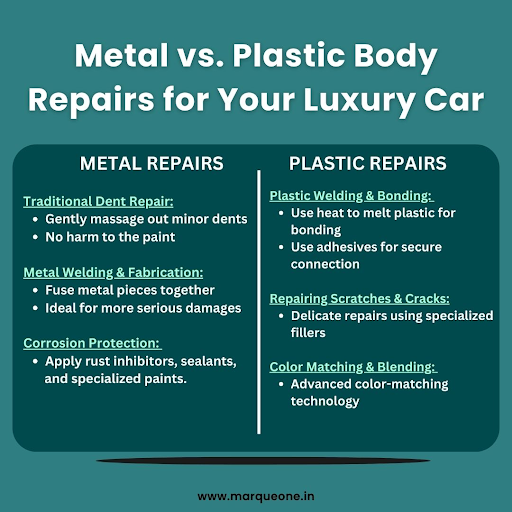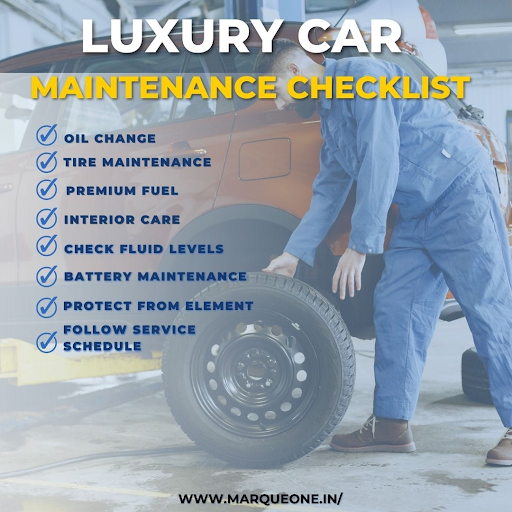The Ultimate Guide to Body Repair For Luxury Cars: Metal vs Plastic

Welcome to the world of luxury cars, where sophistication meets innovation! These extraordinary vehicles have eye-catching designs and feature unique body materials that make them a class apart. Keeping your luxury car in pristine condition is essential for maintaining its value and performance.
In this guide, we'll explore the differences between metal and plastic body repairs, offering valuable insights to help you make the best choices for your prized possession. So, continue reading till the end to learn more.
Understanding Metal and Plastic in Luxury Cars
Differences between Metal and Plastic Materials:
| PROPERTY | METAL | PLASTIC |
|---|---|---|
| Composition | Made from various metallic elements and alloys. | Derived from synthetic polymers, usually derived from petroleum or natural gas. |
| Strength | Generally stronger and more rigid, providing better structural integrity. | Can be more flexible, making them ideal for absorbing impact and reducing vibrations. |
| Weight | Typically heavier, which may affect fuel efficiency. | Lighter, contributing to better fuel efficiency and handling. |
| Durability | Resistant to certain impacts, but may dent or deform under severe force. | Prone to scratching, scuffing, and cracking under extreme stress or temperature changes. |
| Repairability | Often requires specialized welding and fabrication techniques. | Can be repaired using plastic welding, bonding, or replacement methods. |
| Recyclability | Recyclable but may require energy-intensive processes. | More readily recyclable and eco-friendly. |
Common Metal Components in Luxury Cars:
Luxury cars often feature metal components, such as steel or aluminum body filler panels, frames, hoods, doors, and engine components.
Steel is commonly used for its strength and cost-effectiveness, while aluminum is preferred for its lightweight properties, contributing to better performance and fuel efficiency.
Common Plastic Components in Luxury Cars:
Plastic components are widely utilized in luxury cars due to their versatility and design flexibility. Common plastic parts include bumpers, grilles, trim pieces, interior panels, and body panels.
They offer designers greater freedom in creating intricate designs and help reduce overall vehicle weight.
Advantages & Disadvantages: Metal vs Plastic
Both sheet metal and plastic materials come with distinct advantages and disadvantages. Metal provides exceptional strength and structural integrity but may add weight to the vehicle, affecting fuel efficiency.
Conversely, the plastic spreader is lighter, more flexible, and allows for intricate designs but may be more susceptible to damage and require specialized repair techniques.
The choice between autobody metal repair and plastic components often depends on the intended purpose and balance of performance, aesthetics, and cost-effectiveness in luxury car manufacturing and repairs.
Understanding Metal and Plastic in Luxury Cars

Traditional dent repair for metal panels
It is a tried-and-true method used by skilled technicians to erase unsightly dents and dings from luxury cars. Technicians use specialized tools, like sheet metal rods and body hammers, to gently massage the damaged area back to its original shape without harming the paint. This means your car's sleek finish remains untouched, and you can enjoy its pristine look again.
It's an efficient and cost-effective solution for minor dents. It allows you to restore your car's appearance while you save money.
So, the next time an annoying dent appears on your luxury car, remember that automotive bodywork can work wonders.
Metal welding and fabrication
Metal welding and fabrication are the superheroes of luxury car repair regarding more serious damages. Skillful welders use techniques like MIG or TIG welding to expertly fuse metal pieces back together, almost like magical metallurgical surgery.
This process may sound like something out of a sci-fi movie. However, it's a vital part of the rust repair process, ensuring that your luxury car looks as splendid as the day you drove it home from the showroom.
Corrosion Protection and Prevention
Both are essential to maintaining the durability and beauty of luxury cars, especially those with metal components. Picture this: your stunning luxury car's body is susceptible to minor damage caused by moisture, salt, and environmental elements.
Automotive experts utilize various techniques to shield your prized possession from this villain. They may apply protective coatings like rust inhibitors, sealants, and specialized paints, acting as a fortress against corrosive forces.
Restoring the Original Finish
Luxury cars have an unmatched aura of elegance and sophistication, largely owing to their flawless finish and lustrous appearance. However, factors like weather exposure, environmental pollutants, and minor abrasions can dim that radiant glow over time.
Fortunately, restoring the original finish and luster comes to the rescue, bringing back your car's showroom-worthy allure. This procedure involves gentle polishing, waxing, and buffing, expertly executed by skilled detailers.
They delicately remove imperfections, small scratches, and swirl marks, unveiling the car's brilliance. The result? A luxury car that not only looks stunning but also maintains its resale value and pride of ownership.
Hence, when your luxury car needs a touch of magic to regain its captivating charm, trust in the art of restoring the original finish and become a daily driver of your car.

Body Repair Techniques for Plastic Components
Plastic Welding and Bonding Methods:
When repairing plastic components in luxury cars, plastic welding and bonding are a dynamic duo. Technicians use heat to melt the plastic, creating a strong and durable bond. On the other hand, bonding involves using adhesives specifically formulated for plastics, ensuring a secure connection.
These methods are ideal for fixing various plastic parts, from bumpers to interior panels, restoring both aesthetics and functionality. Forming operations for restoration projects, especially on metal work and many other materials is very important.
Just like superheroes joining forces, plastic welding and bonding come together to save the day, making your luxury car look as good as new. Moreover, you can use various machines or apply primer too for this purpose.
Repairing Scratches, Scuffs, and Cracks in Plastic Surfaces:
Luxury cars deserve to be flawless, but sometimes scratches, scuffs, and cracks in plastic surfaces can mar their beauty. Fear not! Technicians use their expertise to perform delicate repairs, erasing these imperfections with precision and care.
Specialized fillers and adhesives are applied to the damaged area, followed by meticulous sanding and reshaping. The result is a smooth surface that's ready for refinishing or blending.
Proper Reshaping Techniques:
In the world of luxury car repair, proper sanding and reshaping techniques for plastics are like artistry in action. Technicians use various abrasive materials and tools to restore plastic components to their original shape and texture. The process requires finesse and skill to avoid causing additional damage or weakening the plastic.
Technicians carefully smooth the surfaces, ensuring a seamless finish that matches the car's contours flawlessly. These techniques are vital for repairing minor damages and preparing plastic surfaces for refinishing or repainting, ensuring your luxury car looks pristine and perfectly sculpted.
Color Matching and Blending for Seamless Repairs:
Luxury cars are renowned for their impeccable appearance, and achieving seamless repairs on plastic components requires color matching and blending expertise. Technicians use advanced color-matching technology to precisely identify the car's original paint hue. They then blend the new paint with the existing one to achieve an invisible transition, making the repair virtually undetectable to the naked eye.
This process ensures that repaired plastic components harmonize flawlessly with the rest of the car, maintaining its high-end aesthetics.
Whether it's a minor touch-up or a more extensive repair, color matching and blending create a blend of colors, making your luxury car look like a work of art on wheels.
Color Matching and Blending for Seamless Repairs:
-
Assessing the Extent of Damage:
-
Evaluating the Material Type (Metal vs. Plastic) for Repair:
When faced with luxury car repairs, the first step in choosing the right repair method is assessing the extent of the damage. Expert technicians carefully examine the affected areas, identifying the severity of dents, scratches, or cracks.
They determine whether the damage is minor and can be easily fixed through traditional dent repair or if it requires more extensive repairs like welding or component replacement. This critical assessment ensures that the appropriate repair approach is chosen, preventing unnecessary costs and ensuring the repair effectively addresses the specific issues.
Luxury cars often combine both metal and plastic components, and choosing the right repair method requires a thorough evaluation of the material type. Skilled technicians consider whether the damaged parts are metal or plastic, as each material demands different repair techniques. Metal repairs may involve welding or reshaping, while plastic repairs require bonding or color matching.
Understanding the materials' unique properties allows technicians to select the most suitable approach, ensuring effective and lasting repairs that restore the car's original beauty and functionality.
Choosing a Reliable Car Repair Shop:
When it comes to selecting a reputable car repair service, several crucial factors come into play. Here are some key considerations to keep in mind:
- Cost Considerations:
- Timeframe for Repairs:
- Impact on the Vehicle's Structural Integrity:
Cost is a significant consideration, as luxury car rust repairs can vary greatly in expense. Technicians weigh the materials, labor, and specialized equipment costs for each repair method.
They also consider the value of the car and the owner's budget, aiming to strike a balance between cost-effectiveness and high-quality results.
Luxury car owners often desire prompt repairs to minimize downtime and inconvenience. Technicians evaluate the time required for each repair method, considering factors such as complexity, availability of replacement parts, and drying or curing times for finishes.
Efficient repairs are prioritized to get the car back on the road swiftly while ensuring meticulous workmanship.
Safety is essential, and any repair decision must consider its impact on the vehicle's structural integrity. Technicians carefully assess whether a repair method compromises the car's safety features or stability.
If structural integrity is at risk, you can choose alternative speed autobody metal repair options that maintain the car's safety standards.
In conclusion, understanding the intricacies of body repair for luxury cars is essential to preserving their opulent aesthetics and performance. Whether it's traditional dent repair for minor imperfections or metal welding and fabrication for more severe damages, skilled technicians play the role of automotive artisans.
Trust in our top-notch service and genuine expertise to restore your car to its pristine state. Visit us at www.marqueone.in to schedule your car repairs now. Your luxury car deserves the best, and Marque One is here to deliver it.
Contact US
- Marque One Garage
- No 116, Manipal County Road, Singasandara, Begur Hobli, Bangalore - 560068.
 Monday
- Saturday 10AM - 6PM
Monday
- Saturday 10AM - 6PM- garage@marqueone.in
 +919353679901, +919113084539
+919353679901, +919113084539
